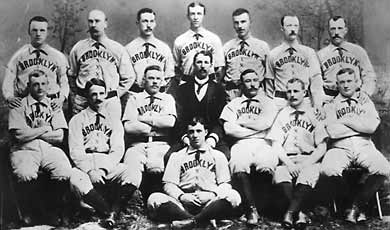Public relations may seem like a modern profession, but people having actually been strategically placing stories in the media for years. As far back as the late 1800s, famous historical figures and occurrences were promoted through smaller scale weekly newspapers.
The Early Years
One of the earliest cases of crisis management through PR was in the 1890s when 80 baseball players left the National League. As you can imagine, fans and owners were in an uproar. With the help of a little media outreach, the National League was able to help straighten out management-labor disputes and secure the relationships amongst the players, fans and owners.

While this may not be the most modern form of PR (and was certainly not called “public relations” at the time), it’s important to be able to relate what happened here to the basics of our job: using interpersonal communication, literature, public events and art to persuade other individuals to believe in our client’s services and/or programs.
The First Publicist
Historical figures such as Henry Ford and Theodore Roosevelt have been attributed with being the first to utilize the basic PR concepts: “positioning” and “ready accessibility.” In other words, these men were able to position themselves as thought leaders who were easily accessible to the press. But it wasn’t until 1906 that a man came along and changed PR forever: enter Mr. Ivy Lee.
Ivy Lee was the first public relations counselor and was hired by famous industrialist John D. Rockefeller. Our friend Rockefeller was facing some serious issues in Colorado, known as the “Ludlow Massacre,” a strike against his fuel and iron plant. In the wake of his panic, Rockefeller turned to our good friend Lee to get the problem fixed, using some traditional media outreach.
So what did our old PR pro Lee do? He decided to change Rockefeller’s tycoon image into one of a man who was concerned for the livelihood of his workers. With this new image in hand, he was able to talk to the press, workers and stage events.
What is PR now?
Through the years, PR eventually evolved from newspaper boys yelling, “Extra! Extra! Read all about it!” to now, where PR specialists focus a large majority of their time on content creation. With the development of the Internet, PR changed drastically. According to Jack Leslie, Chairman at Weber Shandwick, PR has moved from a broadcast model to an engagement model, meaning PR professionals are in a constant two-way conversation with the media.
Now PR specialists are focusing less and less on traditional efforts and are trying to make outreach and engagement with the media more organic. By doing so, the messages that we are offering to editors seem more natural and specific to their interests, rather than a mass email that reads generic and regulated.
From award applications and speaking abstracts to analyst outreach and media relations, our focus is to shape a certain message for our clients based on underlying marketing goals. For example, if our client is looking to connect with potential investors or share their company image to acquire new talent, we might suggest a momentum press release sharing our clients product roadmap, recent awards and current successes. We’ll then pitch an over-arching story to select members of the media (think VentureBeat for investors and local newspapers for employee acquisition).
Below are examples of additional strategies and tactics we use that map back to marketing goals:
- Analyst relations – so products and services can be recommended to companies who aren’t aware of options or who value analysts’ recommendations
- Contributed content campaigns – to promote our client as an industry thought leader
- Media relations gift guides – to allow media contacts to demo products and include them in upcoming gift guides or reviews
- Award applications – to gain exposure about the company and its offerings
The above is just a small sample of tactics we deploy that lead back to a goal established by our client. Content marketing has taken the lead as one of the best strategies for any marketing goal identified.
Here’s a real life example:
Our client was interested in securing coverage and downloads for their annual report and to promote themselves as thought leaders in the marketing industry, while gaining exposure for its product that can help businesses increase conversions. With this goal, in mind we drafted a press release stating the relevant data from the report. We also shared a downloadable link to the report with the media and a PDF version for reference. About a week later, we supplemented the release of the report with bylines describing best practices to increase conversions along with images. And finally, we created an infographic that was then promoted. Our social media tactics complemented our PR efforts which assisted in our goal of securing downloads. Below are the results of our 60-day campaign.
- The Form Conversion Report has been downloaded directly 1,859 times
- The webinar to share key results from the Form Conversion Report attracted nearly 1,000 participants
- Media relations efforts garnered 67 pieces of earned media coverage in publications, including Bulldog Reporter, MarketingProfs and Adweek
- In total, the report received 167,663,871 total impressions
Want to implement modern marketing strategies for your company or brand? Contact Lindsey Groepper to find out how PANBlast can help!
